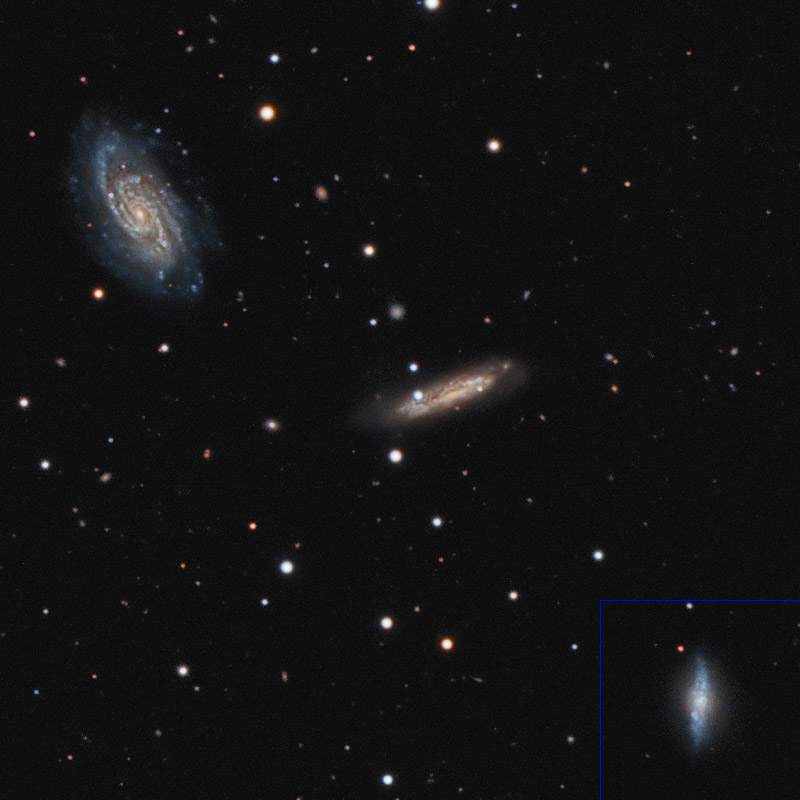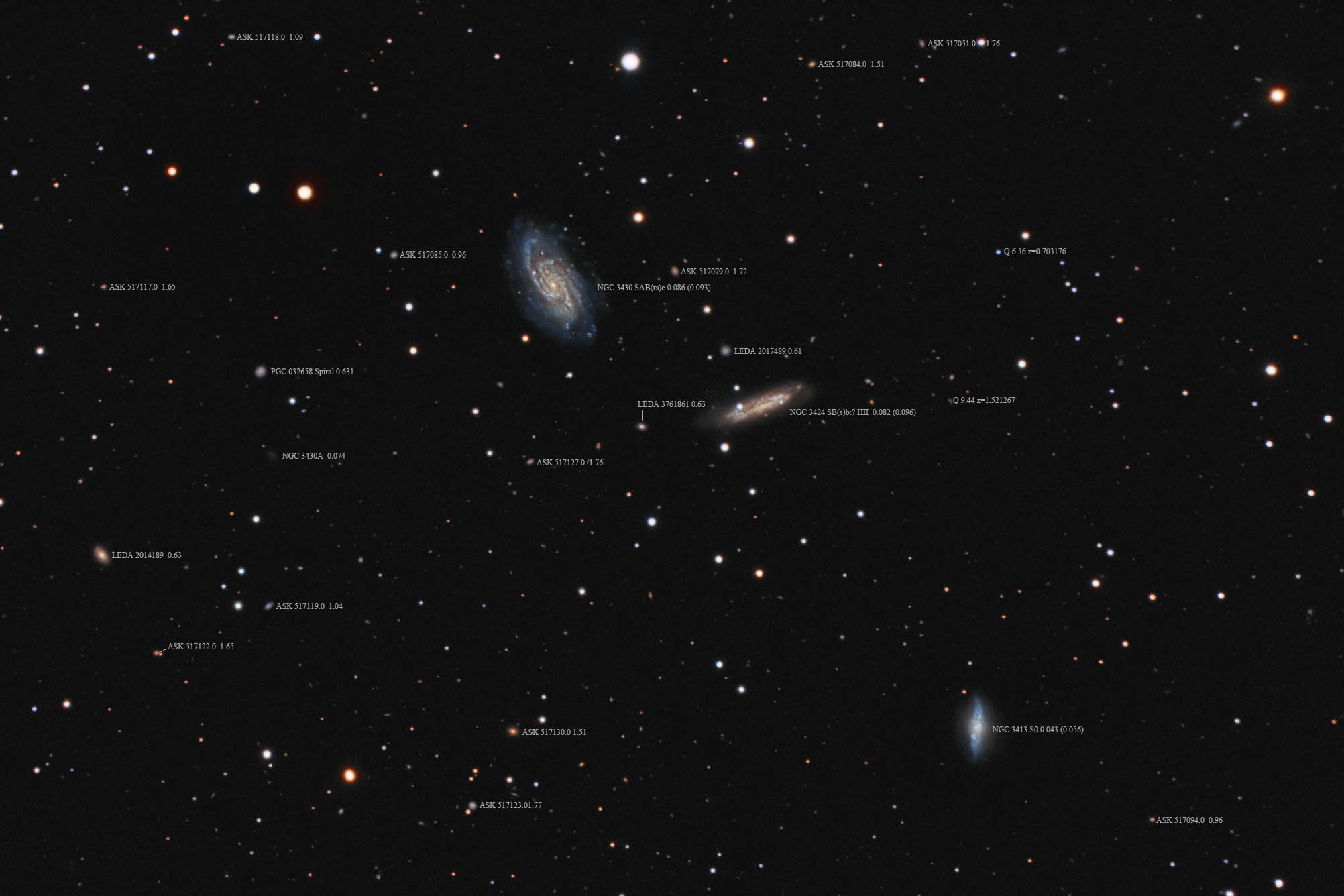Object name: NGC3424Designation(s): NGC3424, NGC3413, NGC3430, The Leo Minor Triplet? Everyone seems to know the Draco Triplet but few seem aware of this triplet located in Leo Minor. All three were discovered by William Herschel on December 7, 1885. The northeastern two are in the second Herschel 400 observing program from the Astronomical League which I'd thought would help with its visibility but apparently doesn't.
The 3 NGC galaxies, 3413, 3424 and 3430 are considered part of the NGC 3396 galaxy group. NGC 3396 along with NGC 3395 are Arp 270 a colliding pair of galaxies northwest of this field. I'm not sure why the center of the NGC 3396 group is near NGC 3424. To me, that would make it the NGC 3424 group. But then I'm not in charge of naming these groups. NGC 3396 has a redshift distance of about 88 million light-years, which is about the same as 3430 and 3424 in this image at 86 and 82 million light-years respectively. However, NGC 3413 is only half that distance at 43 million light-years so likely not at all related to the others.
NGC 3413 is a rather star cluster filled S0 galaxy with no well-defined nucleus. I think we are seeing it rather edge on but that might be an illusion and its shape really is a spindle. At 43 million light-years its diameter is about 22,500 light-years, a rather small S0 galaxy. Tully Fisher estimates put it at 56 million light-years.
NGC 3424 is considered a barred spiral seen close to edge on. it seems to have mostly old red stars with some blue regions in the outer spiral arms. I'd like to see it more face on as it looks quite interesting. Tully Fisher estimates put it 96 million light-years distant. Using the redshift value its diameter is a respectable 76,000 light-years.
NGC 3430 is the only one seen rather face on and has a very active spiral structure with lots of star clouds down its spiral arms. It is classed as SAB meaning it has a bar but also has characteristics of a standard spiral galaxy. In this case, the bar is rather short with the normal spiral structure dominating. It's Tully Fisher estimated distance is only slightly further than the redshift distance. Using the redshift distance of 86 million light-years its diameter is 99 million light-years, about the size of our galaxy. To me, it has three major arms which were one of Arp's peculiar categories though one arm splits into two unequal arms.
The annotated image covers what few galaxies in the field had redshift data at NED. The position of NGC 3430A was vague in NED but the fuzz patch I've labeled for it is the only object in the area that meets their other values for it. Its size is only 6,600 light-years making it a tiny dwarf galaxy.
Due to conditions, I tried for this one on two nights. Both were similarly poor transparency so I just combined the two nights worth of luminance data. Clouds moved in and cut short the round of color data the second night leaving me with no blue that night and only one of red and green. Thus I didn't get twice normal color data. Still, I think it works well.
14" LX200R @ f/10, L=8x10' RG=3x10' B=2x10', STL-11000XM, Paramount ME Related Designation(s):2MASS J10512070+3245598, 2MASS J10514629+3254025, 2MASS J10521140+3257014, 2MASX J10512070+3245589, 2MASX J10514632+3254024, 2MASX J10521141+3257015, 2MASXi J1051207+324558, 2MASXi J1051463+325402, 2MASXi J1052117+325704, 2MFGC 08460, 7C 1048+3310, 7C 1049+3313 NED02, 87GB 104902.3+331055, 87GB[BWE91] 1049+3310, AKARI J1051462+325406, AKARI J1052115+325707, ASK 517091.0, CG 0790, CGCG 1048.5+3301, CGCG 1048.9+3310, CGCG 1049.4+3313, CGCG 184-027, CGCG 184-028, CGCG 184-029, FIRST J105146.3+325402, GALEXASC J105120.75+324600.2 , GALEXMSC J105120.79+324559.0 , HDCE 0609 NED004, HDCE 0609 NED005, HOLM 218A, HOLM 218B, HOLM 218C, IRAS 10485+3301, IRAS 10489+3309, IRAS 10494+3312, IRAS F10485+3301, IRAS F10489+3310, IRAS F10494+3312, ISOSS J10521+3257, KUG 1048+330, KUG 1048+331, KUG 1049+332, LDCE 0743 NED007, LDCE 0755 NED005, LDCE 0755 NED006, LGG 218:[G93] 004, LGG 218:[G93] 005, MCG +06-24-024, MCG +06-24-025, MCG +06-24-026, NGC 3413, NGC 3424, NGC 3430, NGC3413, NGC3424, NGC3430, NSA 090225, NSA 138221, NVSS J105120+324601, NVSS J105146+325405, NVSS J105211+325702, PGC 032543, PGC 032584, PGC 032614, RSCG 38:[WBJ2013] A, RSCG 38:[WBJ2013] B, RSCG 38:[WBJ2013] C, SDSS J105120.73+324558.9, SDSS J105120.74+324558.9, SDSS J105120.74+324559.0, SDSS J105211.40+325701.5, SSTSL2 J105120.60+324558.3, SSTSL2 J105146.29+325402.6, SSTSL2 J105211.39+325701.5, UGC 05960, UGC 05972, UGC 05982, USGC U331 NED03, USGC U331 NED06, UZC J105120.8+324558, UZC J105146.4+325400, UZC J105211.7+325659, UZC-CG 122 NED04, UZC-CG 122 NED05, UZC-CG 122 NED06, [BEC2010] HRS 023, [BEC2010] HRS 024, [M98j] 098 NED03, [M98j] 098 NED04, [RHM2006] SFGs 093, [SLK2004] 0601, [WB92] 1049+3310, | | 

